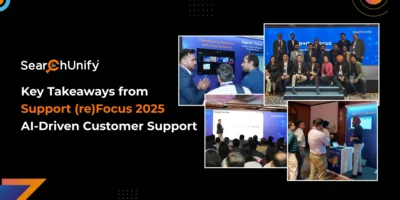
With the evolving digital landscape, data is growing rapidly leading to heaps of information generated within an organization. Now, with these large data repositories, the challenge is to retrieve the right information at the right time.
Traditional searches like keyword search misses the mark in identifying the context and intent of the user to provide relevant results. This leads to dissatisfied customers and negative user experience.
To solve this problem, semantic search acts as a game changer to deliver relevant and contextually accurate responses. With advanced technologies like natural language processing and machine learning, semantic search is capable of understanding the intent behind the user search query, making it more efficient to retrieve results, accordingly.
Now that we have laid the groundwork, let’s dig a little deeper to get a clearer understanding of semantic search and its role in enhancing user experience.
What is Semantic Search?
Imagine you searched for “Apple” in the search bar
Now, As you have likely searched for smartphones earlier…
The results shown to you are not of Apple – “the fruit”
But that of Apple – “the iPhone”.
This is the true magic of functional semantic search. Rather than focusing on exact keyword matching, it understands the context and intent behind the search query. It also takes into consideration user history and then delivers results accordingly. Thus, making it different from traditional keyword searches.
Curious about how semantic search technology works? Let’s dive deeper to understand it more clearly.
It is a step ahead of vector search and requires vector embeddings to understand semantic relationships between various terms. This means that vector search enables semantic search.
But, does semantic search only use vectors?
No, that’s not the case,
It also uses Artificial intelligence (AI) and incorporates technologies like Natural language processing(NLP), Natural language understanding(NLU), and machine learning (ML) to get a complete hold on the intent and context behind the user search query.
Which gets you wondering…
What is its Impact on User Experience?
So far we’ve established the fact that semantic search can take your search experience to the next level. Now, let’s learn more in detail about its impact on user experience and how it can elevate self-service. There are various factors influenced by the semantic search, let’s discuss them one by one:
1. Improved Search Relevance
It adds a layer of understanding by not only focusing on the exact keyword match but also the context and intent behind the user search query. It analyzes language semantics, such as synonyms, related terms, and so on. Additionally, the focus is on interpreting the meaning of words, relationship between them, and context behind user queries to ensure more refined results.
For example, if someone searched for “top mobile phones” the semantic search functionality provides results-focused around “top smartphones”, “top-selling smartphones” and so on, Even if the exact keyword “smartphone” was not used, it was able to understand the context behind the search query and generate accordingly. This is how semantic search works.
This indicates how search results are relevant to the user query, improving search relevance. In entirety adding to customer satisfaction and enhanced customer experience.
2. Personalization
Every customer these days wants a tailor-fit experience that resonates with his tastes and preferences, to ensure this, personalization is the key. Semantic search makes it easier to deliver more personalized responses to the user’s intent of search. It takes into consideration the user journey and their past interactions, not only this, it can fetch results according to users’ date, time, and location so that they are delivered as per their respective time zones.
For instance, let’s suppose you searched for today’s weather, semantic search will provide you results based on your location, date, and time. This means that it will not show the weather of other locations but your current location. This is how semantic search creates a difference. These intricacies lead to a positive user experience.

3. Reduction in browsing time
Consider this, you searched for something and you get exactly what you’re looking for easily without any need for further browsing. How would you feel? Good, right? This is possible with Semantic search. It traces the data in a way that provides you with all the relevant results based on context and intent behind the search query.
Considering this scenario, if a customer finds what he likes within a few clicks, it saves him time from browsing through multiple results pages, before he lands on what he was looking for. This definitely enhances the user experience.
4. Better handling of natural language queries
Who doesn’t want human-friendly search experiences that understand the nuances of everyday human language?
Everyone, right?
Semantic search is a solution for this as well. With the help of advanced technologies like natural language processing(NLP) and natural language understanding (NLU), it never misses the mark to understand the meaning behind a user search query, not only does it do this, it also takes into account jargon, slang, nuances, and complexities of human language to get a clearer view of user intent behind the search query. Thus, it becomes more efficient in making search experience more natural to users as it can comprehend the context behind a query with the utmost accuracy.

5. Multilingual capabilities
Consider this…
You searched for something in your regional language, and to your surprise, the search engine interpreted your query and fetched results in your native language as well.
Also, let’s suppose you typed a query in English and you received results in English as well as various languages that may have some relevant information regarding the same search query.
Both of these above scenarios have added value to your search results. This leads us to say that with multilingual capabilities, the search engine was capable of delivering results from not only a particular language database but also from the worldwide database irrespective of the language barriers. Isn’t that amazing?
With semantic search, this has become possible now. It has broken down the language barriers to deliver relevant and crucial information to the user. This capability has taken user experience to the next level.
Conclusion
We can say that semantic search has emerged as a powerful tool to revolutionize the search experience. With this, it has become easier to deliver more personalized, relevant, and accurate responses.
The result?
It has led to an era where the accuracy and relevance of search results are up to the mark and time spent on browsing through search result pages has reduced significantly. This has led to a positive user experience and has increased customer satisfaction.
Further, as these semantic capabilities advance rapidly, we can expect a boost in intelligent search as well as user expectations to provide a remarkable user experience.
In this direction, SearchUnify’s Cognitive Search with its AI-powered capabilities is all set to advance towards a responsive digital landscape.
Are you ready to take the plunge?
If Yes,
Then, Request a demo today!











